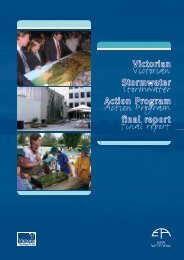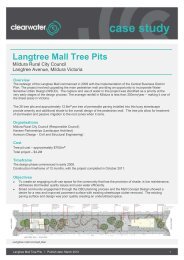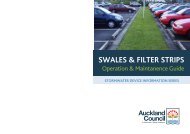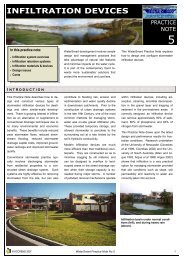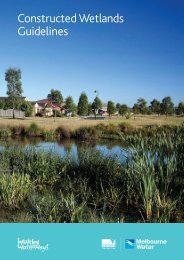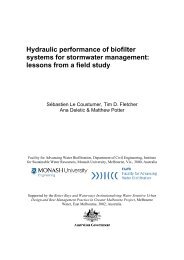CRC Street Sweep Eval 1999.pdf( 489.9 KB ) - Clearwater
CRC Street Sweep Eval 1999.pdf( 489.9 KB ) - Clearwater
CRC Street Sweep Eval 1999.pdf( 489.9 KB ) - Clearwater
You also want an ePaper? Increase the reach of your titles
YUMPU automatically turns print PDFs into web optimized ePapers that Google loves.
COOPERATIVE RESEARCH CENTRE FOR CATCHMENT HYDROLOGY<br />
6 Pollutant Types<br />
The effectiveness of street sweeping to remove<br />
pollutants, across the typical range of particle sizes<br />
found on street surfaces, has not yet been successfully<br />
quantified for Australian conditions. The examination<br />
of street sweeping effectiveness in the present study<br />
focuses on two pollutant types:- (i) gross pollutants<br />
and litter and (ii) sediment and associated<br />
contaminants. Gross pollutants have been defined as<br />
any solids that are retained by a 5 mm mesh screen by<br />
Allison et al. (1998) and this definition is adopted<br />
here. Solids washed off street surfaces which are<br />
smaller than 5 mm and not considered to be gross<br />
pollutants include a proportion of litter and organic<br />
matter but are predominantly sediment particles,<br />
typically between the course sand to fine silt range,<br />
and sediment associated contaminants.<br />
6.1 Gross Pollutants<br />
Allison et al. (1997a) undertook an investigation into<br />
the types of gross pollutants derived from an urban<br />
catchment. The study found typical urban gross<br />
pollutants transported by stormwater to include litter<br />
(predominantly paper and plastics) and vegetation<br />
(leaves and twigs) as shown in Figure 6.1. Organic<br />
matter comprised the largest proportion by mass of<br />
the collected gross pollutants and therefore should be<br />
a major consideration in street cleaning programs.<br />
The data was based on field monitoring of gross<br />
pollutants retained in a Continuous Deflective<br />
Separation (CDS) unit treating a catchment area of 50<br />
hectares in Coburg, an inner city suburb of<br />
Melbourne.<br />
Only a small number of investigations have examined<br />
street sweeping effectiveness on gross pollutant<br />
removal. Nilson et al. (1997) conducted an<br />
investigation into source control of gross pollutants in<br />
Adelaide and attempted to assess the efficiency of<br />
street sweeping for gross pollutant removal in<br />
stormwater. This study sought to quantify the amount<br />
of gross pollutants entering the drainage network in<br />
three similar streets swept at different intervals.<br />
Catch baskets in side entry pits were used to collect<br />
gross pollutants which were not otherwise collected<br />
by the sweeper for a street swept every day, once a<br />
week, and not at all. Trapped pollutants in these<br />
Personal<br />
Paper<br />
Commercial<br />
Plastic<br />
Metals<br />
Others<br />
Personal<br />
Plastic<br />
Vegetation<br />
Figure 6.1 Composition of Gross Pollutants by Mass (Allison et al., 1998)<br />
13




